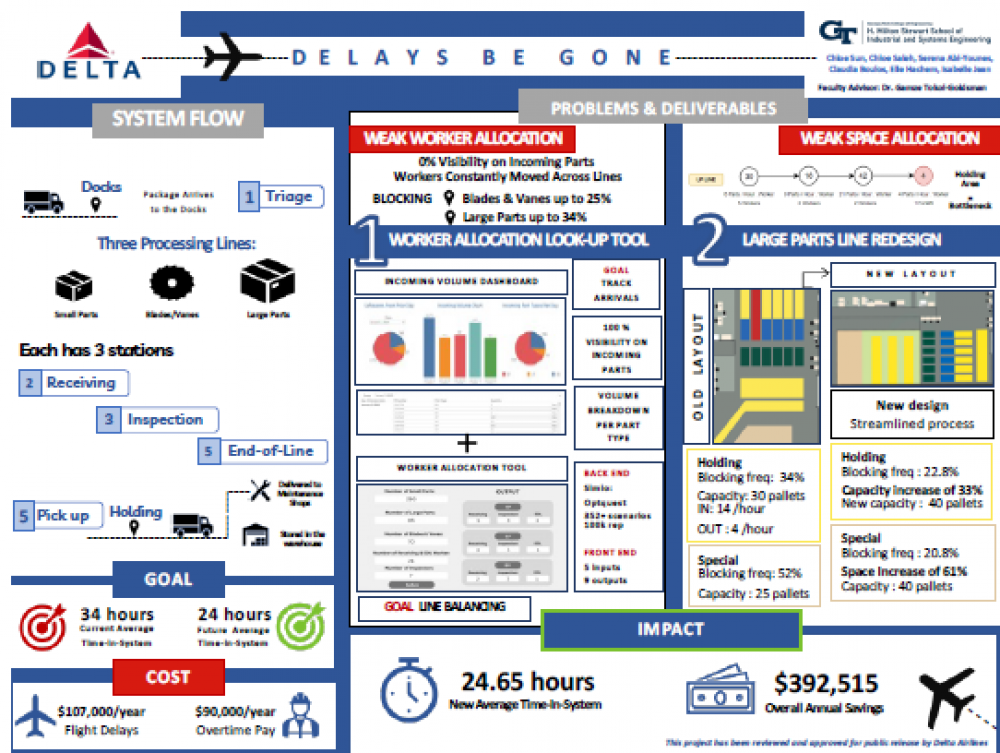Client Context
The client for this project is Delta Airlines’ Technical Operations (TechOps) warehouse, which is responsible for receiving, inspecting, storing, and delivering aircraft parts to Hartsfield-Jackson International Airport and its hubs. The warehouse receives approximately 1,200 parts/day that are either stored in an Automated Storage and Retrieval Systems (AS/RS), used to replenish existing inventory at Delta’s maintenance shops, or sent to satisfy a specific need for Delta’s aircraft.
This project focuses on the receiving function which involves daily package arrivals on trailers that operate on a weekly schedule. Once arrived, each package containing a part(s) and its corresponding paperwork, is unloaded at the docks and assigned an internal tracking sticker. The package is then sent to one of three processing lines depending on the type of part it carries: Large Parts (over 35lbs., LP), Small Parts (under 35 lbs., SP), and Blades & Vanes (BV). Each line consists of one of the following stations (See Appendix A):
-
Receiving: A worker will open the box and enter the purchase order into the system to ensure the part that arrived is the part ordered.
-
Inspection: Inspectors verify that the part was sent with the appropriate certifications and that it has been handled in compliance with government regulations at every facility it has been to prior to arriving at the warehouse.
-
End-of-Line (EOL): The part will undergo a final overall check. Then, it receives a label that indicates one of three put-away destinations: inventory within the warehouse, inventory at a different warehouse, or a maintenance/repair shop. After completing EOL, the package is placed on a small cart or a large pallet to wait in a holding area for transportation to its destination.
Project Objective
This project aims to reduce the average time-in-system for every part from 34 hours to 24 hours. This means the client can process all parts received in one day within 24 hours on a rolling clock.
High average time-in-system leads to two main costs for the client: $107,000/yr. in flight delays and $90,000/yr. in overtime pay.
Design Strategy
To form a better understanding of the reality of the warehouse, the team decided to build a simulation model that replicates the current operations. However, due to the client’s lack of data on the current system, the team performed time studies to collect data samples for processing times, forklift travel times, line capacities, and daily arrivals. The collected data, along with worker and truck schedules provided by the client, formed the basis of the simulation model, which the team used to pinpoint the bottleneck in each processing line. The team identified 2 main opportunities:
1) Worker Allocation
The client encounters difficulties in effectively assigning their workforce due to limited information on incoming parts. The client does not know the expected daily volume of parts arriving at the facility, therefore they are unable to allocate their resources in advance and ensure that there are enough workers at each station to handle the incoming load.
2) Space Allocation
The Large Parts line experiences a lot of blocking due to space limitations, which is why the team looked to modify the warehouse layout to better allocate space to the lines that need it.
Deliverables
Deliverable 1A: Incoming Volume Dashboard
The team used Python to scrap data from Delta's invoices, and stores it into an Excel sheet. This allowed the team to store key data such as the Delivery Date. Using Tableau, the team consolidated this data into a dashboard that depicts: (1) a bar chart of the expected incoming volume, (2) a pie chart of the incoming volume on each processing line (SP, LP, BV), (3) a pie chart of the leftover volume per processing line from the prior day, and (4) a consolidated list of all the daily incoming parts’ PO Numbers, Part Type, Quantity, and Type
Deliverable 1B: Worker Allocation
Now that the client knows what to expect daily the team decided to provide a worker allocation tool considering the daily incoming volume and the total number of workers. The team used an optimization engine OptQuest that using the data collected on processing times at each station, calculates which worker allocation across the warehouse results in the lowest average time-in-system. The results were consolidated into an Excel sheet and a lookup table: the client is now able to input how many parts are arriving at a given day (using our dashboard), and how many workers are available on shift, and outputs where these workers need to be placed to achieve a better throughput.
Deliverable 2: Warehouse Layout
The team decided to focus on redesigning the layout at the Large Parts processing line for multiple reasons. Firstly, the Large Parts line sees the most blocking/starving in the warehouse, up to 34% of the time. Secondly, the Small Parts and Blades&Vanes lines operate on conveyor belts which are difficult and costly to move, while the LP is sectioned using tape on the floor.
The new layout represents a streamlined process across the processing line workstations to align with the inflow of packages from the docks. Moreover, the holding area has now increased by 33%, which means it can hold 10 more pallets. Knowing that this area is the bottleneck of the Large Parts line, it has reduced the blocking at that station by 12%.
Value and Impact
After implementing the deliverables, the average time in system decreased by 27.51%, attaining a value of 24.65 hours.
By achieving the 24-hour goal, the team estimates saving a total cost of $392,515/year that encompasses the overtime pay and Sunday shift reductions. This value is conservative, as it does not include any value for flight delay reduction. After working extensively with the client and their financial team, it was not possible to quantify the change in dollar amount associated with the reduction of time in the system. Despite this, the client is confident that reducing the average time-in-system will have a significant impact on flight delays.


